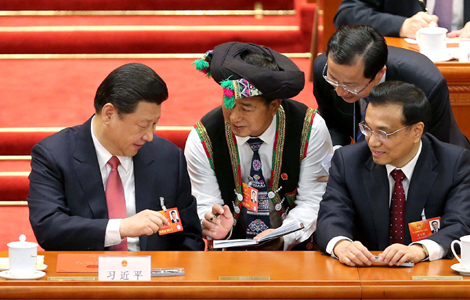Nonprofits hurt by red tape and support gap
Many gaps between urban and rural schools could be bridged by fostering the nonprofit sector's development, especially in the area of grassroots initiatives.
This sector brings innovation, experience and resources that give oomph to the local governments' ambitions to compress the disparity between schools in the cities and in the countryside.

Capitalizing upon the momentum generated by the so-called third sector requires a streamlining of bureaucracy over nonprofits, particularly small grassroots organizations, and extensive partnerships with governments.
I have worked at a leadership level with two nonprofits devoted to the development of China's rural education. I find that only 440,000 of the roughly 3 million nonprofits in China had officially registered before 2011, as the China Charity and Donation Information Center reports. In other words, about 90 percent operate in gray areas, which often leaves them in functional limbo.
One of the rural education groups I work with, which trains principals for the farthest-flung schools, took refuge under a registered foundation.
It discovered that extracting money for projects can be like pulling teeth. It can take half a year to get cash - and there's a 10 percent management fee.
The other organization, which I founded to bring solar panels to schools without electricity in western China, and provides daily necessities and their first computers - which we equip with 3G - struggles with capacity-building.
We're fighting to sustain the capacity we have already built. We cannot collect donations from the public without registering. So funding - all of which goes to projects - is limited to our own pockets.
This means we only have 10,000 yuan ($1,600) to install more than two solar panels in a school each year. Our annual budget for other work is, at best, 30,000 yuan.
We haven't been able to launch a website or provide more than one computer per school. We're barely able to cover shipping for the clothes and school supplies we send out. There are times where we have to turn away clothing because there is insufficient cash to ship or store it. It snows year-round in the communities with which we work, winters reach -25 C and most people live in tents.
A streamlined registration process and operating requirements would enable grassroots groups like us to raise money from the general public, appeal to corporate donors and apply for grants.
We are just one of the many grassroots nonprofits struggling with the same challenges. Were the sector cut free from the red tape, it could push forward the day when all schools in the west have electricity.
The World Bank reports that nomads from Qinghai province who have electricity are two-thirds more likely to be able to read if they have access to solar panels. The lack of power is a culprit in the province's 10 percent illiteracy rate - the country's second highest, after the Tibet autonomous region.
China's government has advanced rural education. The central government has devoted vast sums to remote, nomadic schools. But western China's pedagogical needs are even vaster.
Local governments lack revenue sources, as the high altitudes where we work - it is impossible to plant crops - hamper economic production.
While the government has the will but not the way to better fund such communities' schools, the for-profit private sector has scant incentive to engage these mostly subsistence herding communities, as the people have little purchasing power. Corporate social responsibility projects are typically executed through registered nongovernmental organizations, which are relatively scarce.
Ultimately, the nonprofit sector could plug many holes in remote schools' pedagogical capabilities that others can't - if its grassroots component is unbridled.
NGOs in the United States have invested more than 20 billion yuan in China since the reform and opening-up in 1978. They've contributed roughly 2 billion yuan annually in recent years, the charity report estimates.
With simplified registration and operating procedures, and closer partnerships with government organs, nonprofits could grow in size and have larger influences. The multiplication of their capabilities could transform the country's remotest schools.
Contact the writer at erik_nilsson@chinadaily.com.cn


